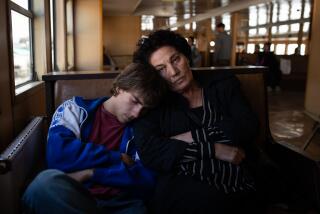Class conflicts -- this time in a Turkish ghetto
- Share via
If Jerome Robbins and Leonard Bernstein had followed their original plans for a Broadway musical about class conflicts on the streets of New York, its title would have been “East Side Story.” However they moved in the opposite direction, so that title belongs to the problematic full-evening dance drama by choreographer Aysun Aslan and composer Fahir Atakoglu that the Istanbul National Ballet offered in the second of two performances Friday at the John Anson Ford Amphitheatre.
Based on a novel by Metin Kacan, the two-act work focused on a family living in a crime-ridden Istanbul ghetto and, as such, represented an extraordinary project for a major state-supported cultural institution. The company evolved from a dance academy founded by Ninette de Valois, mother superior of England’s Royal Ballet, and, like the Royal, it dances a wide range of classical and contemporary pieces. But it would be hard to imagine the Royal -- or the Paris Opera Ballet or the Kirov Ballet or American Ballet Theatre -- depicting the lower depths of its home city’s slums as the Turks dared to do.
Although ballet technique dominated the passages for the warring gangs and the solos for such superb virtuosos as Baris Adikti (a gang boss), the movement vocabulary also incorporated gypsy folklore, gymnastic modernism, pop dancing -- even a belly dance showpiece for Jaklin Carkci. And, again, few dance ensembles anywhere could deliver so many idioms with such authority as the 40 Turks and 20 locally recruited Americans performing in the production.
Moreover, Atakoglu’s taped score sounded utterly at home in every style, with lush symphonic lyricism layered over invigorating folk rhythms. As in Istanbul itself, you journeyed from Europe to Asia and back without ever leaving a unique environment.
Unfortunately, Aslan’s choreography proved so terminally addicted to woozy, panoramic melodrama -- and so intent on rushing us through one act of brutality after another -- that the work quickly grew repetitive and enervating. Promising movement ideas surfaced with no chance for development. Important actions and dancers flew by with no time for involvement or appreciation. And, sad but inevitable, many of the principals settled for broad, superficial acting to carry them through the melee.
Hardworking but not always well used, Sibel Surel, Alkis Peker, Can Tunali and Selim Borak played the central family members, with Ebru Cansiz, Seyda Sofuoglu and Canan Sadalak cast as the women who changed their destinies. Tunali, in particular, projected a fearsome intensity as a tormented youth emerging as the vengeful neighborhood godfather.
Los Angeles would be fortunate to see these dancers return in other repertory. The fusion of talent and passion that their company offered at its best Friday seemed just as precious as those huge uncut emeralds in the Topkapi Palace. Alas, “East Side Story” proved just as fundamentally shapeless.
More to Read
The biggest entertainment stories
Get our big stories about Hollywood, film, television, music, arts, culture and more right in your inbox as soon as they publish.
You may occasionally receive promotional content from the Los Angeles Times.










